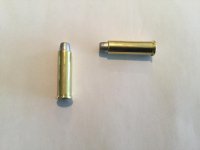38SPL HV
Member
Loaded a classic....Lyman 358477 in 357 Magnum cases.
Cases: Starline 357 Magnum
OAL: 1.510” per Lyman cast bullet data
Bullet: Lyman 358477, 155 gr as cast
Powder: 11.0 grs of 2400
Primer: CCI-500
Crimp: Lee taper crimp 5/8 turn after solid case mouth contact
Velocity: 1,030 FPS (Ruger 4 5/8 BH)
Comments: pleasant shooting with very good accuracy. A 38-44 load in 357 Magnum cases. Good working load.
Pictures:
Cases: Starline 357 Magnum
OAL: 1.510” per Lyman cast bullet data
Bullet: Lyman 358477, 155 gr as cast
Powder: 11.0 grs of 2400
Primer: CCI-500
Crimp: Lee taper crimp 5/8 turn after solid case mouth contact
Velocity: 1,030 FPS (Ruger 4 5/8 BH)
Comments: pleasant shooting with very good accuracy. A 38-44 load in 357 Magnum cases. Good working load.
Pictures:
Attachments
Last edited:

